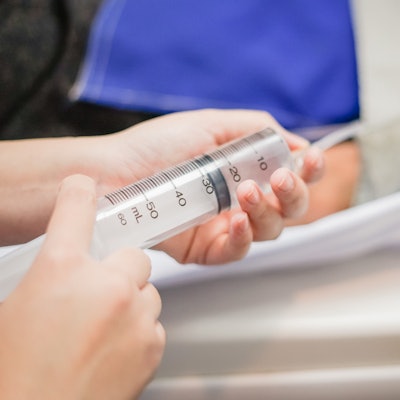
Two relatively simple measures can reduce incidence of contrast extravasation on CT imaging, according to a study published March 1 in Academic Radiology by researchers from Japan.
The two measures -- assessing patients' vein vulnerability to intravenous injection and implementing particular scanning practices -- could translate to better patient outcomes, wrote a team led by Shinsuke Shigematsu of Kumamoto University Hospital in Japan.
"Implementation of a venous vulnerability assessment and prevention scan protocol rules by a radiology team can be a practical and simple solution to reduce the risk of extravasation of contrast media during CT," the group noted.
Contrast media extravasation is a well-known complication on CT imaging and can occur even when intravenous injection is conducted properly, the team explained. Most of these leaks are small and resolve without major negative effects on patients, but some can be more severe and may include tissue necrosis or complications such as loss of sensation, burning, prickling, aching, or numbness. The risk factors for contrast extravasation during CT imaging include the following: female sex, older age, smaller catheter size, longer catheter placement time, faster injection rate, and greater contrast viscosity.
Shigematsu and colleagues sought to evaluate the effect of two prevention strategies the radiology department at Kumamoto University Hospital took to minimize incidence of contrast leaks during CT imaging. One of the tactics was to utilize a "venous vulnerability" assessment, in which department members use a checklist to gather information on patient age, obesity/thinness, skin fragility, and difficulty of catheter placement. The other approach added scan protocol rules for imaging patients who were considered to have venous vulnerability -- decreasing injection rate and using low tube voltage imaging or low-energy virtual monochromatic imaging.
The study included 73,931 patients who underwent CT exams with contrast between January 2013 and December 2019. Study data were divided into three time periods:
- Period A: 2013 to 2014, no prevention measures
- Period B: 2015 to 2016, venous vulnerability assessment only
- Period C: 2017 to 2019, both venous vulnerability evaluation and the use of extravasation prevention protocols
Of the total patient cohort, 0.39% (292 individuals) experienced contrast extravasation during CT. The investigators found that the combination of venous vulnerability assessment and specific protocols proved most effective for avoiding contrast leaks; this result was statistically significant.
| Impact of contrast extravasation prevention efforts by study period | |||
| Measure | No prevention measures | Venous vulnerability assessment | Venous vulnerability assessment and use of extravasation prevention protocols |
| Frequency of contrast extravasation on CT imaging | 0.62% | 0.43% | 0.24% |
The study results indicate that preventing complications such as contrast leaks during CT imaging can be relatively simple, the group noted.
"[Our study demonstrates] that venous vulnerability assessment and prevention scan protocol rules implemented as preventive strategies were effective for reducing the frequency of extravasation of contrast media during CT," the team wrote. "The strategies are considered to be simple and clinically practical, and the radiology team (radiology nurses, radiology technicians, radiologists) can play an important role in preventing [contrast leaks] during CT."




















